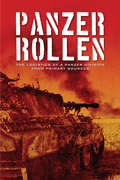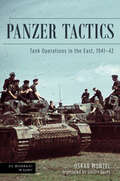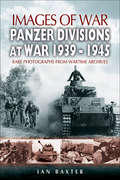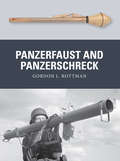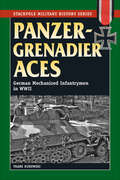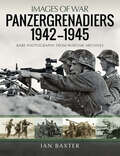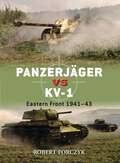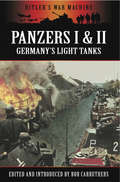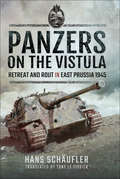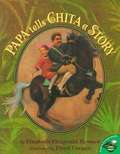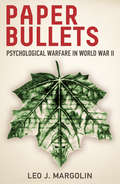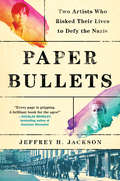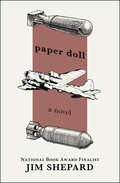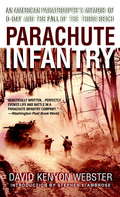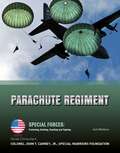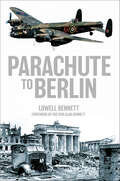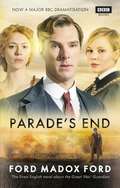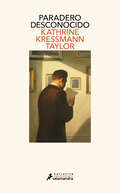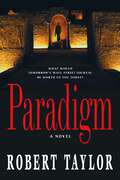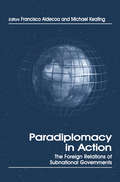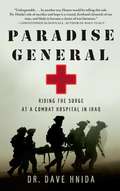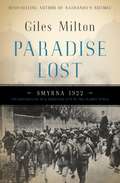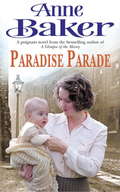- Table View
- List View
Panzer Rollen: The Logistics of a Panzer Division From Primary Sources
by Bob CarruthersPanzer Rollen provides an insightful look in to the workings of the Military Intelligence Service that was so invaluable in shaping both the strategy and tactics of the Allied forces during the Second World War.
Panzer Tactics: Tank Operations in the East, 1941–42 (Die Wehrmacht im Kampf)
by Oskar MunzelA detailed analysis of raids and advances taken by panzer units on the Eastern Front in 1941–42. This book discusses a number of operations undertaken by the XXXXVIII Panzer Corps in the direction of the Black Sea in 1941 and 42. It explores the tactics used and why they were successful, based upon the detailed combat reports prepared by the corps staff immediately after each battle. Die Wehrmacht im Kampf is a series published in Germany in the 1950s and 1960s. Written by ex-members of the German army in WWII, it provides important information not available elsewhere on the German army’s perspective of many crucial campaigns and battles. None of the volumes have previously been available in English. Each volume has a modern introduction by Professor Matthias Strohn, expert on the German army.
Panzer-Divisions at War, 1939–1945: Rare Photographs From Wartime Archives (Images Of War Bks.)
by Ian BaxterFrom the beginning in 1935 this attractive book describes the different elements that went into the Panzer-Divisions. It describes how the Germans carefully built up their assault forces utilizing all available reserves and resources into making an effective fighting machine. It depicts how these awesome formations grew to be used four years later in war, and provides much historical information and facts about the vehicles and its components that fought in all the campaigns of the war from the early victorious Blitzkrieg in Poland and France to the last ditch defense in Germany in 1945. Each chapter features unseen photographs of light tanks, main battle tanks, assault guns, anti-tank destroyers, artillery, reconnaissance units, support vehicles, pioneers with their bridge building platforms and the motorized infantry or Panzergrenadiers.This book is a visual treat for the military enthusiast and collector and a worthy addition to the Images of War series.
Panzerfaust and Panzerschreck
by Gordon Rottman Johnny ShumateThese lethal man-portable anti-tank weapons enabled Wehrmacht infantry to destroy T-34 and Sherman tanks. Written by an expert on anti-tank warfare, this book reveals the fascinating development history of the Panzerfaust and Panzerschreck and accessess the tactics that were employed by the soldiers using these two feared weapons.Two of World War II's most distinctive weapons, the Panzerfaust and Panzerschreck offered German and other infantrymen the ability to destroy enemy tanks singlehandedly at close range. While the Panzerschreck owed its origins largely to the US bazooka, the Panzerfaust was a revolutionary design that was unlike any previous weapon, and went on to influence anti-tank technology and tactics for decades after World War II.Germany had begun World War II with several inadequate antitank weapons for infantry use, supplemented by improvised and captured weapons and, from 1942, a hand-delivered 3kg antitank shaped charge. As the fortunes of war turned against Germany, what was desperately needed was an antitank weapon that allowed the individual soldier to destroy a tank. The first effort to field such a weapon began with the Faustpatrone 43, a handheld short tube with a propellant charge and an over-caliber, shaped-charge warhead; it was the first of the Panzerfaust ("armor fist") series of anti-tank weapons. The warhead was propelled by a launcher cartridge. The sights were extremely crude, but more sophisticated sights were unnecessary owing to the short ranges and the fact that tanks were large targets. Panzerfaust models were designated by two- or three-digit numbers indicating their approximate range in meters. The reloadable Panzerfaust 250 was under development a the war's end, as was an anti-personnel high-explosive-fragmentation projectile.The Panzerfaust was not manned by a dedicated crew but was issued to individuals. Training was extremely simple and given in the form of a lecture and demonstrations, often without even any live fire. German propaganda made much of the Panzerfaust capable of being use by Hitler Youth teenagers, old men of the Volkssturm and other civilians. Over eight million Panzerfauste of all types were produced, and they became as widely used as hand grenades. They proved to be comparatively effective against tanks and other armored fighting vehicles, as well as fortifications and buildings. Allied troops, notably Soviet forces, made widespread use of captured Panzerfauste, and they were also supplied to German allies such as Finland, Hungary, and Bulgaria. The Germans provided the Japanese with examples and plans for the Panzerfaust and they went on to develop their own reloadable and very different version called the 45mm Type 5 recoilless anti-tank weapon; it was to be used to defend the Home Islands.
Panzergrenadier Aces: German Mechanized Infantrymen in World War II (Stackpole Military History Series)
by Franz KurowskiThis WWII history sheds light on the operations and combat experiences of Hitler&’s &“armored infantry&”. As the foot soldiers who went into battle alongside the Third Reich&’s fearsome tanks, the panzergrenadiers occupied a unique position in the German war machine. Whether in the Wehrmacht or Waffen-SS, these troops endured all the horrors of infantry combat—fighting hand-to-hand, storming enemy positions, and rescuing fallen comrades—but they did so in the shadow of thundering armored fighting vehicles like the Tiger and Panther. In Panzergrenadier Aces, Franz Kurowski vividly recounts many of these soldier&’s most dramatic stories, offering a rare window into their role in the larger conflict while bringing them and their actions to life.
Panzergrenadiers 1942–1945: Rare Photographs From Wartime Archives (Images of War)
by Ian BaxterUsing 250 photographs, this addition to the Images of War series examines Hitler's elite armored infantry: the Panzergrenadiers.The term Panzergrenadier was introduced in 1942 and applied equally to the infantry component of Wehrmacht, Luftwaffe and later Waffen-SS Panzergrenadiere divisions. As this classic new Images of War book describes, these elite divisions fought as mechanized infantry and escort for and in close cooperation with panzers and other armoured fighting vehicles. Trained to fight both mounted and on foot, their priority was to maintain the fast momentum of armoured troops on the battlefield. Using a wealth of rare, often unpublished, photographs with detailed captions and text, the author charts the fighting record of the Wehrmacht and Luftwaffe Panzergrenadiertruppe units. This includes their initial successes on the Eastern Front. But as defeat approached, they were forced on the defensive on all fronts including the bitter fighting in Italy and the Western Front. As well as describing their many actions, the book details the vehicles and weapons used and main personalities.
Panzerjäger vs KV-1
by Robert Forczyk Ian PalmerAs the Wehrmacht invaded the Soviet Union, it discovered that the Russians possessed heavy tanks that German anti-tank guns were ineffective against. The German Army developed the 37-mm Pak 36 in 1936 to provide the primary weapon for its panzerjagers, who were responsible for anti-tank defense in infantry divisions. Realizing that the new Wehrmacht offensive doctrines intended to fully exploit the shock effect, firepower and mobility of armor, the panzerjagers were intended to enable German infantry to fend off enemy tanks. Although the Pak 36 was adequate against most pre-war tanks, during the 1940 Campaign in the West it proved unable to defeat the British Matilda II or French Char B, so the Wehrmacht began developing the 50-mm Pak 38 to supersede it. However, the process of re-equipment was slow and most German infantry divisions that participated in the invasion of the Soviet Union in 1941 only had a handful of Pak 38s and still relied mainly on the Pak 36. Just four days into the invasion, German troops encountered the first KV-1 and KV-2 tanks near Raisinai in Lithuania and the impotence of both the Pak 36 (soon derisively labeled the "Door Knocker") and the Pak 38 was revealed. Thus at the start of this decisive campaign, the German Army was faced with the reality that it's panzerjagers could not provide effective anti-tank defense against Soviet heavy tanks and the Wehrmacht was forced to adopt a crash-program to upgrade its division-level AT defenses. New weaponry, including the 75-mm Pak 40, captured Soviet 76.2-mm guns converted into Pak 36(r), HEAT shells and tungsten-core rounds, offered possible solutions to the Soviet armored behemoths, but would require time to develop. In the interim, the panzerjagers were forced to adopt a variety of ad hoc tactics and stand-in equipment to survive in an unequal duel with heavy Soviet tanks. On the Soviet side, based upon lessons from the Spanish Civil War, the Red Army decided to develop a heavy "breakthrough" tank to smash enemy infantry defenses. The result was the KV-1 and KV-2 tanks, introduced in 1939. At the start of Operation Barbarossa, both these tanks were virtually invulnerable to the weapons of the panzerjager and demonstrated their ability to overrun German infantry on several occasions. This advantage gave the Red Army a window of opportunity between the fall of 1941 and the spring of 1942 to use their heavy tanks to repel the German invasion in a series of desperate counteroffensives. Yet the window of Soviet advantage was a narrow one and the duel between the Soviet KV heavy tanks and German panzerjagers had a major impact upon the struggle for the strategic initiative in 1941-42.From the Trade Paperback edition.
Panzers I & II: Germany's Light Tanks (Hitler's War Machine)
by Bob CarruthersThe first vehicle to be produced in any numbers for the Panzerwaffe was the tiny Panzer I known as the MG Panzerwagen. Almost from the outset the limitations of the design for the Panzer I were obvious. It was essentially a training vehicle which was only pressed into service as a last resort. It was to be succeeded by the Panzer II which could at least engage armoured cars and combat against tanks with approximately the same armour as itself.Together these two tanks formed the bulk of the armour which between 1939 and 1941 conquered half of Europe.This comprehensive overview of the light Panzers in action was compiled by Emmy Award winning historian Bob Carruthers. It draws heavily on war-time intelligence reports to produce a fascinating insight into the development and combat history of the light Panzers at the tactical and operational level.Also featured are rare developments such as the Panzer II flame thrower variant alongside unpublished photographs and illustrations which provide an absorbing study, from an array of primary sources, of the world of the light Panzer and their crews from contemporary Allied sources.
Panzers on the Vistula: Retreat and Rout in East Prussia 1945
by Hans SchäuflerThis WWII memoir of a Nazi officer is one of the most revealing firsthand accounts of the German retreat on the Eastern Front. A second lieutenant of the 4th Panzer division, Hans Schäufler commanded a Jagdpanther tank destroyer in rearguard actions against the Red Army in East Prussia in 1945. Then, as an infantryman, he took part in the doomed defense of Danzig before escaping across the Baltic in a small boat. His personal story offers a rare glimpse into the chaos and suffering endured by tens thousands of soldiers and civilians during the collapse of the Third Reich in the east. Along with vivid descriptions of the appalling conditions in Danzig and the fear and panic that gripped the city, Schäufler&’s account provides valuable insight into the German army&’s tactics as they fell back before the Soviet advance. While acute shortages of men, equipment, ammunition and fuel crippled the defense, the soldiers went on fighting for a lost cause in the face of certain defeat.
Papa Tells Chita a Story
by Elizabeth Fitzgerald HowardIn a companion to the award-winning Chita's Christmas Tree, Chita's papa, now a doctor, tells his imaginative little girl about the secret mission he went on while a soldier during the Spanish-American war.
Papaya Salad
by Elisa MacellariThe debut graphic novel from Thai-Italian illustrator Elisa Macellari, Papaya Salad tells the story of her great-uncle Sompong who found himself in Europe on military scholarship on the eve of World War II.A gentle and resolute man in love with books and languages, in search of his place in the world, Sompong chronicles his life during the war and falling for his wife, finding humor and joy even as the world changes irrevocably around him This Winner of the 2019 Autori di Immagini Silver Medal in the Comics category tells the human story of the War, from a perspective not typically seen."An historical and emotional journey through my family and my roots that are grown between Europe and Asia. A personal narrative that needs to be shared and hopefully arouses empathy in the reader." -- Elisa Macellari
Paper Bullets: Psychological Warfare in World War II
by Leo J. MargolinPaper Bullets, first published in 1946, is an overview of some of the propaganda methods used by the Allied and Axis countries in World War II. This “psychological warfare,” highly effective in many cases, was used to demoralize the enemy, spread falsehoods, influence soldiers to surrender, serve as “safe-conduct” passes, provide a source of reliable news, and warn civilians of impending bombardments. Thousands of lives were likely saved by the use of leaflets, dropped from airplanes or sent over enemy lines via specially designed artillery shells. The book also examines Nazi and Japanese propaganda aimed at U.S. audiences. Included are 50 pages of propaganda examples used during the war by the Americans, Germans, and Japanese. Author Leo Margolin served in the Army's Office of War Information (OWI), Psychological Warfare Branch, established during World War II and responsible for most of the American propaganda efforts during the war.
Paper Bullets: Two Artists Who Risked Their Lives to Defy the Nazis
by Jeffrey H. Jackson&“A Nazi resistance story like none you&’ve ever heard or read.&” —Hampton Sides, author of Ghost Soldiers and On Desperate Ground"Every page is gripping, and the amount of new research is nothing short of mind-boggling. A brilliant book for the ages!&” —Douglas Brinkley, author of American Moonshot Longlisted for the Carnegie Medal for Excellence in NonfictionPaper Bullets is the first book to tell the history of an audacious anti-Nazi campaign undertaken by an unlikely pair: two French women, Lucy Schwob and Suzanne Malherbe, who drew on their skills as Parisian avant-garde artists to write and distribute &“paper bullets&”—wicked insults against Hitler, calls to rebel, and subversive fictional dialogues designed to demoralize Nazi troops occupying their adopted home on the British Channel Island of Jersey. Devising their own PSYOPS campaign, they slipped their notes into soldier&’s pockets or tucked them inside newsstand magazines. Hunted by the secret field police, Lucy and Suzanne were finally betrayed in 1944, when the Germans imprisoned them, and tried them in a court martial, sentencing them to death for their actions. Ultimately they survived, but even in jail, they continued to fight the Nazis by reaching out to other prisoners and spreading a message of hope. Better remembered today by their artist names, Claude Cahun and Marcel Moore, the couple&’s actions were even more courageous because of who they were: lesbian partners known for cross-dressing and creating the kind of gender-bending work that the Nazis would come to call &“degenerate art.&” In addition, Lucy was half Jewish, and they had communist affiliations in Paris, where they attended political rallies with Surrealists and socialized with artists like Gertrude Stein.Paper Bullets is a compelling World War II story that has not been told before, about the galvanizing power of art, and of resistance.
Paper Doll: A Novel
by Jim ShepardDuring the air war over Germany, the crew of a B-17 Flying Fortress tries to achieve some competence as a unit before their most catastrophic mission yet They call their plane &“Paper Doll,&” the joke being its suggestion of flimsiness, inconsequence, and perishability, and none of them, from the veterans to the newcomers, feel the bravery they&’d like to project. But now, despite their myriad limitations, they&’ve been tasked with living through the tension and boredom of base life, saving one another&’s lives, and rejoicing at those missions they&’ve survived—until they&’re confronted by the shock of a mission directed against the ball-bearing factories in Schweinfurt, a mission that will outfly the capacities of their fighter escorts and take them hundreds of miles through the most heavily defended sectors of the German Air Defense. National Book Award finalist and author of The Book of Aron Jim Shepard brilliantly illustrates both the lunacy and intimacy of these young men&’s lives on the ground as well as their growing disillusionment and terror at what lies ahead. Unsentimental and unsparing in its honesty, Paper Doll portrays with stirring clarity the realities of war and the bonds forged in the face of death.
Parachute Infantry: An American Paratrooper's Memoir of D-Day and the Fall of the Third Reich
by David Webster<p>David Kenyon Webster's memoir is a clear-eyed, emotionally charged chronicle of youth, camaraderie, and the chaos of war. Relying on his own letters home and recollections he penned just after his discharge, Webster gives a first hand account of life in E Company, 101st Airborne Division, crafting a memoir that resonates with the immediacy of a gripping novel. <p>From the beaches of Normandy to the blood-dimmed battlefields of Holland, here are acts of courage and cowardice, moments of irritating boredom punctuated by moments of sheer terror, and pitched urban warfare. Offering a remarkable snapshot of what it was like to enter Germany in the last days of World War II, Webster presents a vivid, varied cast of young paratroopers from all walks of life, and unforgettable glimpses of enemy soldiers and hapless civilians caught up in the melee. <p><i>Parachute Infantry</i> is at once harsh and moving, boisterous and tragic, and stands today as an unsurpassed chronicle of war--how men fight it, survive it, and remember it. NOTE: This edition does not include photos.</p>
Parachute Regiment (Special Forces: Protecting, Building, Te)
by Jack MontanaThe Parachute Regiment is one of the toughest units in the U.S. military and in the world. Its training course is designed to push recruits to their limits; only those who are strong in mind and body can pass the course. This book will take you through the entire training course. Only when the recruits have show real endurance can they even begin parachute training, working up to the moment they proudly receive their parachute wings badge. This book gives amazing insights into the training, including: * How the recruits cope with carrying an 80-pound pack. * The bizarre equipment needed for parachute training. * What it takes to jump out of a balloon at 800 feet. * How these men have proved their levels of endurance in war.
Parachute to Berlin
by Lowell BennettThe vivid account of a war correspondent shot down over Germany and taken prisoner.Bennett was one of several journalists to fly a night raid over Berlin in November 1943. This is the vivid testimony of an American journalist shot down over Berlin. After he was captured in Berlin, he was taken on a tour of Germany and shown what the civilian population was being subjected to. Bennett spent the rest of the war in Stalag Luft I, where he started the newspaper POW WOW, secretly read by 9,000 prisoners. Bennett's experiences led him to condemn the Allied policy of systematically bombing civilian population centers.
Parade's end
by Madox FordThis classic novel centres on Christopher Tietjens, an officer and gentleman. It follows him from the secure, orderly world of Edwardian England into the chaotic madness of the First World War. Against the backdrop of a world at war, the complex sexual warfare between Tietjens and his faithless wife Sylvia is played out. This is a story about love, betrayal and disillusionment in a time of horror and confusion.
Paradero desconocido
by Kressmann TaylorUna novela visionaria que, sin asomo de complacencia ni demagogia y un sorprendente final, expone la tragedia íntima y colectiva de la Alemania nazi. Concebida como un intercambio epistolar entre Max Eisenstein, un comerciante de arte judío residente en San Francisco, y su socio comercial, Martin Schulse, que había regresado a Alemania en 1932 y escribe a su socio desde allí, Paradero desconocido cuenta el trágico desarrollo de una amistad y la historia de una amarga venganza. Construida con un suspense insuperable, desconcertantemente breve, en el que no sobra ni falta una palabra, esta novela magistral describe vívidamente el veneno en descomposición del nacionalsocialismo. Un relato visionario que, sin asomo de complacencia ni demagogia y un final sorprendente, expone la tragedia íntima y colectiva de la Alemania nazi. La crítica ha dicho...«Un cuadro premonitorio de la Alemania de Hitler a través de un intercambio de cartas entre dos alemanes a ambos lados del Atlántico.»Le Parisien «El libro está inspirado en la transformación ideológica que sufrieron unos alemanes que regresaron a su país tras haber vivido en Estados Unidos. Eran cultos e inteligentes, pero no toleraban críticas a Hitler. En un viaje a California se negaron a saludar a un amigo judío con el que se cruzaron. "¿Qué los había llevado a ese grado de crueldad?", se preguntó al presenciar esta escena la autora, Kressmann Taylor. Y escribió Paradero desconocido.»ABC «Una perfecta novela corta escrita por su autora para concienciar a sus amigos alemanes atacados de antisemitismo y en ella se narra un episodio de la persecución alemana a los judíos que impacta doblemente al lector: por su dramatismo y por su resolución literaria. Un libro único.»El País «En el terreno de la ficción, la estadounidense Kressmann Taylor publicó en 1938 (¡en 1938!) Paradero desconocido, una premonitoria advertencia contra la vesania nazi y el Holocausto, cuando sobre los campos de concentración solo había rumores y sospechas. Esta maravillosa y breve novela epistolar es a la literatura lo que es al cine El gran dictador.»La Vanguardia «La perfección misma. La denuncia más eficaz del nazismo hecha en un libro de ficción.»The New York Times Book Review
Paradigm: A Novel
by Robert TaylorGOLD MEDAL FOR FICTION, 2006, MILITARY WRITERS SOCIETY OF AMERICA What is tomorrow’s Wall Street Journal worth to you today? Where is the line between reality and fiction? Are the financial markets really predictable? Does an ancient artifact hold the key to how some of the world’s wealthiest families made their fortunes? When a mysterious granite and cypress Egyptian box is found hidden away in a secret room in the palatial Biltmore Estate, twin scientists Alex and Nicholas Shepard work to unlock the secret of its intricate dials, gauges, crystals, and carvings. What they discover has the potential to make them rich beyond their wildest dreams. But it could also collapse financial markets, bankrupt corporations around the globe, and destroy many of the world’s most powerful families. As the twins quickly find out, people will not only kill to make money, but will kill to keep it. What begins as a simple scientific experiment in the stock market quickly descends into a nightmarish intrigue of murder, deception, and mystery. When one Shepard brother is killed, the surviving twin and his wife find themselves in a desperate gambit to learn the truth about the box’s legacy. Using ancient documents found with the box, they unearth clues to trace its history through the ages, from the catacombs of Paris to the Knights of the Templar in Scotland. Their investigation takes them from London to Paris, Venice, and finally, to the Vatican itself, where they uncover the greatest deception ever perpetuated by man. Robert D. Taylor’s enthralling debut novel “Paradigm” is a unique and masterful blend of intelligent scientific suspense and bold historical mystery stretching from earliest antiquity to the present day—and beyond. His intriguing plot and cast of memorable characters makes for a suspenseful pager-turn that will keep readers guessing about where the lines of reality and fiction merge. “Paradigm” demands we believe the unbelievable. The challenge of finding out just what is truly real and what is not is now up to you.
Paradiplomacy in Action: The Foreign Relations of Subnational Governments (Routledge Studies in Federalism and Decentralization #Vol. 4)
by Michael Keating Francisco AldecoaOffering a general view of the development of subnational foreign action around the world, this work covers topics such as the repercussions upon subnational autonomy of the progressive consistution of international regimes such as the EU, NAFTA and APEC.
Paradise General: Riding the Surge at a Combat Hospital in Iraq
by Dave HnidaIN 2004, AT THE AGE OF FORTY-EIGHT, DR. DAVE HNIDA, a family physician from Littleton, Colorado, volunteered to be deployed to Iraq and spent a tour of duty as a battalion surgeon with a combat unit. In 2007, he went back--this time as a trauma chief at one of the busiest Combat Support Hospitals (CSH) during the Surge. In an environment that was nothing less than a modern-day M*A*S*H, the doctors' main objective was simple: Get 'em in, get 'em out. The only CSH staffed by reservists-- who tended to be older, more-experienced doctors disdainful of authority--the 399th soon became a medevac destination of choice because of its high survival rate, an astounding 98 percent. This was fast-food medicine at its best: working in a series of tents connected to the occasional run-down building, Dr. Hnida and his fellow doctors raced to keep the wounded alive until they could be airlifted out of Iraq for more extensive repairs. Here the Hippocratic Oath superseded that of the pledge to Uncle Sam; if you got the red-carpet helicopter ride, his team took care of you, no questions asked. On one stretcher there might be a critically injured American soldier while three feet away lay the insurgent, shot in the head, who planted the IED that inflicted those wounds. But there was levity amid the chaos. On call round-the-clock with an unrelenting caseload, the doctors' prescription for sanity included jokes, pranks, and misbehavior. Dr. Hnida's deployment was filled with colorful characters and gifted surgeons, a diverse group who became trusted friends as together they dealt with the psychological toll of seeing the casualties of war firsthand. In a conflict with no easy answers and even less good news, Paradise General gives us something that we can all believe in--the story of an ordinary citizen turned volunteer soldier trying to make a difference. With honesty and candor, and an off-the-wall, self-deprecating humor that sustained him and his battle buddies through their darkest hours, Dr. Hnida delivers a devastating and inspiring account of his CSH tour and an unparalleled look at medical care during an unscripted war.
Paradise Lost
by Giles MiltonOn Saturday, September 9, 1922, the victorious Turkish cavalry rode into Smyrna, the richest and most cosmopolitan city in the Ottoman Empire. The city's vast wealth created centuries earlier by powerful Levantine dynasties, its factories teemed with Greeks, Armenians, Turks, and Jews. Together, they had created a majority Christian city that was unique in the Islamic world. But to the Turkish nationalists, Smyrna was a city of infidels.In the aftermath of the First World War and with the support of the Great Powers, Greece had invaded Turkey with the aim of restoring a Christian empire in Asia. But by the summer of 1922, the Greeks had been vanquished by Atatürk's armies after three years of warfare. As Greek troops retreated, the non-Muslim civilians of Smyrna assumed that American and European warships would intervene if and when the Turkish cavalry decided to enter the city. But this was not to be. On September 13, 1922, Turkish troops descended on Smyrna. They rampaged first through the Armenian quarter, and then throughout the rest of the city. They looted homes, raped women, and murdered untold thousands. Turkish soldiers were seen dousing buildings with petroleum. Soon, all but the Turkish quarter of the city was in flames and hundreds of thousands of refugees crowded the waterfront, desperate to escape. The city burned for four days; by the time the embers cooled, more than 100,000 people had been killed and millions left homeless.Based on eyewitness accounts and the memories of survivors, many interviewed for the first time, Paradise Lost offers a vivid narrative account of one of the most vicious military catastrophes of the modern age.
Paradise Lost
by Giles MiltonOn Saturday, September 9, 1922, the victorious Turkish cavalry rode into Smyrna, the richest and most cosmopolitan city in the Ottoman Empire. The city’s vast wealth created centuries earlier by powerful Levantine dynasties, its factories teemed with Greeks, Armenians, Turks, and Jews. Together, they had created a majority Christian city that was unique in the Islamic world. But to the Turkish nationalists, Smyrna was a city of infidels. In the aftermath of the First World War and with the support of the Great Powers, Greece had invaded Turkey with the aim of restoring a Christian empire in Asia. But by the summer of 1922, the Greeks had been vanquished by Atatürk’s armies after three years of warfare. As Greek troops retreated, the non-Muslim civilians of Smyrna assumed that American and European warships would intervene if and when the Turkish cavalry decided to enter the city. But this was not to be. On September 13, 1922, Turkish troops descended on Smyrna. They rampaged first through the Armenian quarter, and then throughout the rest of the city. They looted homes, raped women, and murdered untold thousands. Turkish soldiers were seen dousing buildings with petroleum. Soon, all but the Turkish quarter of the city was in flames and hundreds of thousands of refugees crowded the waterfront, desperate to escape. The city burned for four days; by the time the embers cooled, more than 100,000 people had been killed and millions left homeless. Based on eyewitness accounts and the memories of survivors, many interviewed for the first time, Paradise Lost offers a vivid narrative account of one of the most vicious military catastrophes of the modern age.
Paradise Parade: A gripping saga of love and betrayal
by Anne BakerA young woman discovers that all that glitters is not gold... Anne Baker writes a gripping saga of love, secrets and class struggles in Paradise Parade. Perfect for fans of Dilly Court and Sheila Newberry.Living above her stepfather's fish and chip shop on Merseyside's Paradise Parade, Emily Barr is glad to escape to the relative peace of her job in Wythenshaw's jewellery factory. And when she is promoted to work for young Mr Giles, the son of the owner, she is the envy of all her workmates. What a catch he would be!Much to her surprise, Emily finds the eligible Giles is trying to woo her, and when he proposes she willingly accepts. But Giles is not the suitable suitor he appears to be and Emily soon discovers that the marriage isn't quite what she'd hoped for... What readers are saying about Paradise Parade: 'Anne Baker is a great novelist, every book I have read of hers is brilliant!''This book is an excellently researched book of the period. [You] really empathise with Emily and can almost smell the chip shop odours'
